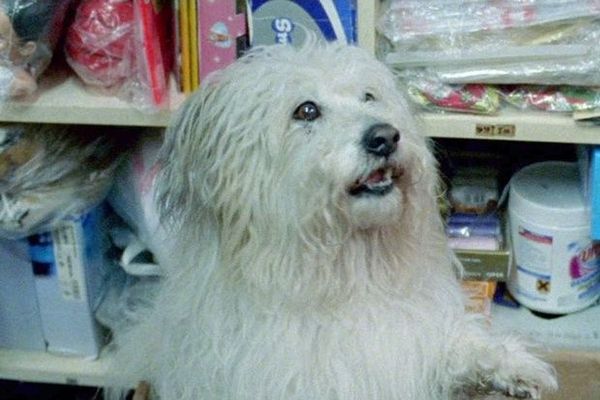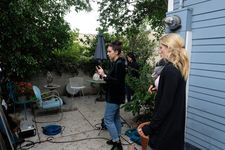 |
| Brea Grant in Lucky Photo: Courtesy of Fantasia |
Natasha Kermani is one of the most interesting filmmaker of her generation. Having loved her 2017 film Imitation Girl, I was excited to hear that her latest work had been picked up by Fantasia and arranged to see it as soon as possible.
Lucky, written by Brea Grant (who plays lead character May and has another film, 12 Hour Shift, which she directed, also at the festival) is the story of a woman who persistently finds that a man is trying to kill her, but who doesn’t seem to to be able to get anyone to treat the matter with sufficient seriousness. It’s a complicated piece of work with a lot gong on under the surface. Natasha tells me that the script spoke to her straight away.
“When I read Brea’s script it just felt very real for me and it felt like ‘Okay, this is something that we can definitely do,’” she says. “Imitation Girl was distributed by Epic Pictures and at the time Rob, one of our producers, had been looking at Lucky, so he sent it to me, thinking that I might respond to it, and I did and I emailed Brea immediately, basically saying ‘I’m interested in this. If you’ll have me, I’m on board.’”
 |
| Natasha Kermani on the set of Lucky Photo: Cidney Hue |
They plunged straight into redrafting and working out the practicalities of making it, she says, and started filming by summer 2019, aiming for a March 2020 première.
“It was always Brea as the lead,” she tells me. “The script was presented to me as a vehicle for Brea to star in. I think she had some questions in her mind abut whether or not she wanted to play that role and be in that mental space, but we talked it through and she was open to it, so it was really great to be able to build the film around her. She’s so centred and charismatic; she’s such a professional, and I say that with all the love and respect that comes with that. I think professionalism is hard to find sometimes.
“Immediately we were able to figure out ‘Okay, she’s going to be the rock of the project,’ and then we cast around her and we built the world round her. That was really great for me. For me, to have something solid at the centre of it, be it a location or an actor or an actress, or whatever it might be, it’s a great jump-off point when you’re trying to do things quickly and maybe you don’t have all the resources in the world.
“We put in the time in our prep work to make sure that we were on the same page before we even got to the point where we were talking to potential department heads or casting other actors, so there was no discrepancy when it came to interpreting her script. We worked everything out ahead of time.”
Was it useful to have Brea on set in her capacity as writer as well as star?
“Yep. She would sometimes do little dialogue passes in the moment. But for the most part I think she really embraced the idea of ‘Okay, another filmmaker is coming to my work,’ so she never was trying to assert her identity as a filmmaker. She was really there as an actor and as a writer to service the new vision of the project. I’m very grateful for that, but yeah, it’s always great to have the writer on set!”
Did they always envision the film drawing on the established language of horror films?
“Yeah, definitely. I think we both appreciate a good satire and looking at things from a different perspective, from a crooked angle. I think that’s one of her great strengths as a writer, is that she’s very funny. I think we are poking fun at the traditional slasher, so it’s a satire of a slasher, but I think the dna of it is not a slasher. I think of it as like an episode of The Twilight Zone, or something more alternative.”
There’s a scene about two thirds of the way through, set in a parking garage, which invites viewers to think again about what they’ve seen so far.
“That scene in the parking garage is where I put the script down and pulled up my laptop and emailed Brea and told her that I wanted to do the movie,” she says definitively.” I think what I saw was the potential to take the audience on a journey where in the beginning we’re giggling a little bit at the awkwardness and the funnier side of it but by the time we get to that third act and we’re moving towards the end of the film, the story opens up. Suddenly we realise that there’s a broader context for this single perspective that we’ve been following.
“At that point I thought to myself ‘If I can bring the audience from that place of giggling in the scenario to you can hear a pin drop in the theatre, then you’ve created an entry point for a very dark issue and a very dark conversation through a place of lightness and humour and satire to a place where we’re actually able to have a meaningful conversation about these issues. That was a really difficult challenge for me. It is a balancing act, for sure, but that was all in Brea’s script and was there from the very first draft that I read.
“From that point on I was just trying to figure out how to pull it off. We had very limited resources. So how could we do that so that this whole movie was barrelling towards that parking garage scene, and how could we structure our resources so that we could pull that scene off? So we made some changes to the script and restructure our resources s that that turn into the third act could work in the way that I wanted it to work.”
There are stylistic choices she makes early on that affect the way we interpret events. I raise the way that she positions the camera whilst May is trying to explain her situation to detectives, using the visual language of the crime film to invite is to sympathise with the detectives’ perspective as they calmly question her bizarre story.
She wanted to address classic cinematic tropes, she says, so she’s glad that those scenes resonated with me in that way – but there’s more. “It’s also that she is questioning herself. It’s not just that we’re questioning her but she herself is hearing these words come out of her mouth and thinking ‘Wait a minute, that sounds completely crazy. This guy seems very normal and steady. He’s looking at me like I’m nuts. Am I nuts?’ So that’s all part of the language there.”
I ask about the physical challenges of shooting a film in which the lead characters have to fight over and over again.
“It’s hard, it’s really hard,” she says. “I had some experience with stunts going into this so – similar to the parking garage scene – I knew that we had to be very conscious of scheduling, money, prep, rehearsal, because we would be completely screwed if we turned up and we were not 100% ready to go. We were lucky enough to work with an amazing woman stunt coordinator. We wanted a woman to be embodying May’s experience so that she would bring her own physicality into it. We had a stunt double for some of the crazier moves but most of the stunts that you see in the movie are Brea.
“We did some rehearsals, we blocked it out, made sure everybody felt comfortable. The actor who plays The Man [Hunter C Smith] is also a stuntman. That was also a priority for me from the very beginning. We were lucky enough to find the perfect guy. Hunter was amazing.”
How did she approach directing Hunter when his face was covered by a mask?
“He did use his face. I would say that he was acting with his whole body, face included... Hunter is a creature performer so he really understands that kind of idea. He can extend his body into a puppet or something like that. He can control his body to express what we’re trying to express. When we were interviewing potential actors for The Man that was something that I wanted to talk about upfront.
“He’s another character in the scenes. He has his own motivation. One thing we talked about is that he’s a little bit like a toy soldier, with the stiffness in his back and the way he stands. I think those little cues were helpful for him to integrate into his performance.”
She’s really happy about the film being picked up by Fantasia, she says. It’s a festival she has always wanted to attend.
“To be able to be there with a film is something that I’ve wanted for years and years. It’s a bit bittersweet to be talking to you from my apartment instead of over a drink in Montreal, But yeah, I think their programming is amazing, they have so much respect, and I think that a lot of talent comes out of the festival. I hear it’s one of the most fun genre festival experiences so I hope to be there in the future.”
Does this mean that she’s planning to do more genre work?
“Yeah,” she says. “I think genre is really a home for me. Probably most of the projects that I’ll be doing will have some genre spin to them. It’s what I’m a fan of and it’s fun. If you’re a filmmaker with expressionistic leanings, there’s no better place to do that, to create worlds that are designed to express your theme or your story or your character – that’s the ultimate aim for me, and then every aspect of your filmmaking is able to be integrated into that world.”
I mention that other directors whose work has ended up at horror festivals almost by accident, when they hadn’t thought of what they were making as horror, have told me that they find horror audiences very accepting, especially of experimental work.
“100%. Absolutely,” she agrees. “I think horror fans are very open minded. They are totally open to whatever might come their way. Whether they love it or they hate it, they’ll watch it. And they’re going to think about t and they’re going to talk about it. I just love that. It’s such an engaged community. I think that’s really special. I’m also a big science fiction person. I think often that overlaps with the horror community and I think there’s a lot of fun stuff there too, sort of cross-genre. Again the community is really supportive and awesome.”
She’s spending her time in lockdown writing and reading and doing preparatory work, she says, and she hopes to be back on set in 2021.
Lucky is screening at Fantasia on Sunday 23 and Friday 28 of August





















